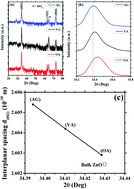Role of point defects on the enhancement of room temperature ferromagnetism in ZnO nanorods
Abstract
Vertically aligned undoped ZnO

* Corresponding authors
a
Centre for Nanoscience and Nanotechnology, School of Physics, Bharathidasan University, Tiruchirappalli, India
E-mail:
kjeganathan@yahoo.com
b Centre for High Pressure Research, School of Physics, Bharathidasan University, Tiruchirappalli, India.
c Department of Laser Studies, School of Physics, Madurai Kamaraj University, Madurai, India.
d Crystal growth and Thin film Laboratory, School of Physics, Bharathidasan University, Tiruchirappalli, India.
Vertically aligned undoped ZnO

 Please wait while we load your content...
Something went wrong. Try again?
Please wait while we load your content...
Something went wrong. Try again?
P. S. Venkatesh, V. Purushothaman, S. E. Muthu, S. Arumugam, V. Ramakrishnan, K. Jeganathan and K. Ramamurthi, CrystEngComm, 2012, 14, 4713 DOI: 10.1039/C2CE25098E
To request permission to reproduce material from this article, please go to the Copyright Clearance Center request page.
If you are an author contributing to an RSC publication, you do not need to request permission provided correct acknowledgement is given.
If you are the author of this article, you do not need to request permission to reproduce figures and diagrams provided correct acknowledgement is given. If you want to reproduce the whole article in a third-party publication (excluding your thesis/dissertation for which permission is not required) please go to the Copyright Clearance Center request page.
Read more about how to correctly acknowledge RSC content.
 Fetching data from CrossRef.
Fetching data from CrossRef.
This may take some time to load.
Loading related content
